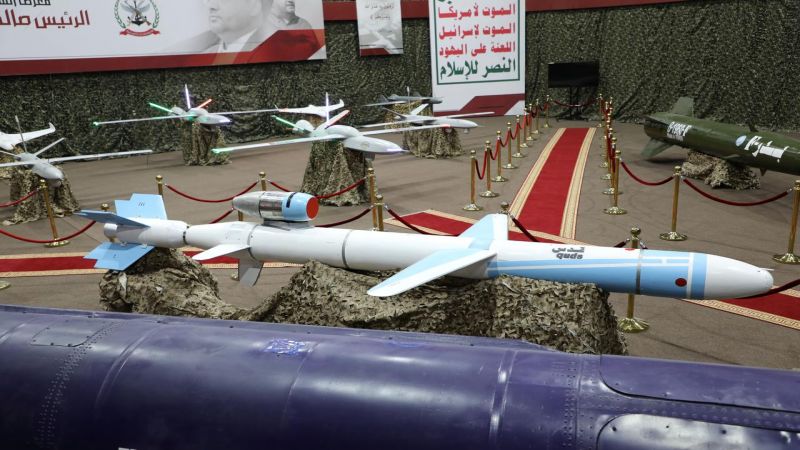
Local Editor
At a weapons exhibition in July in Yemen’s capital Sanaa, military officials whipped silken sheets off what they said were newly-developed drones and missiles.
The theatrical gesture revealed the proud slogan “Made in Yemen” spray-painted onto the weapons’ bodywork.
The moment was a celebration of sorts for Yemen’s Houthi fighters. Despite years of air strikes against them, the movement now boast drones and missiles able to reach deep into Saudi Arabia, the result of an armament campaign pursued and expanded energetically since Yemen’s war began four years ago.
Whether or not the revolutionaries carried out Saturday’s crippling raid on a Saudi oil plant — as it asserts — its capabilities mean it can feasibly claim responsibility for the strike, a humiliating blow against its top adversary.
Much remains unclear about the attack: Some Western officials believe responsibility lies with Iranian-backed militias in Iraq, or Iran itself.
What is certain is that Houthi weapon capabilities have evolved rapidly in the past couple of years in accuracy and distance, analysts, U.N. data and Houthi media indicate.
In one unverified Houthi video, a covert launch vehicle rises robotically out of the desert floor and fires off missiles thousands of feet into a clear blue sky, before retracting into its hiding place.
“They are getting better on accuracy,” a Saudi-based security source said. “The message they’re sending is: We are getting through and we are hitting the right locations.”
“As these technologies - long range drones or cruise missiles - spread, it really adds to the distance of warfare. It also adds to the deniability of the perpetrator,” said James Rogers, assistant professor in War Studies at University of Southern Denmark.
The Houthis’ growing military clout has checked Saudi ambitions in Yemen. Riyadh leads a coalition that intervened in 2015 to forcefully restore the resigned regime of former President Abd-Rabbu Mansour Hadi.
The Houthis have built their arsenal using local manufacturing and foreign expertise. They also took over large swathes of Yemen’s conventional military, including Scud missiles.
The Saudi-led coalition said in June the Houthis had fired 226 ballistic missiles and 710,606 “projectiles” during the war.
This proliferation has taken place despite a years-long air and sea blockade on Houthi-controlled parts of Yemen and years of strikes the coalition say are against weapons depots, drone manufacturing locations and military communications hubs.
The Houthis’ reach has been getting longer.
A new type of Houthi drone appeared in mid-2018 which the U.N. has said can fly up to 1,200-1,500 km (745 to 932 miles) - putting Riyadh, Abu Dhabi and Dubai within range.
A 2018 study of Houthi’s military by Michael Knights of the Washington Institute for Near East Policy said the clearest example of direct Iranian help with advanced Houthi weaponry was the Burkan 2-H medium-range ballistic missile.
He said wreckage from 10 Burkan missiles suggested they were smuggled into Yemen in pieces and welded back together by a single engineering team, whose “fingerprint non-factory welding technique” was found on all the missiles.
Iran denies arming the Houthis and says it played no part in Saturday’s strike, which raised already simmering tensions in the region between Tehran and its Gulf and U.S. adversaries.
President Hassan Rouhani said the attacks were carried out by “Yemeni people” in response to the Yemen war.
The Houthis, who have this year also hit smaller oil targets and airports in southern Saudi, said they carried out the Aramco strikes with unmanned aerial vehicles.
The U.N. says the Houthis’ arsenal now also includes anti-ship cruise missiles, waterborne improvised explosive devices, ballistic and cruise missiles and rockets.
The group seized some of the Yemeni armed forces’ arsenal when it invaded Sanaa in 2014. But none of these had the range seen today, said Jeremy Binnie, Middle East and Africa editor for Jane’s Defence Weekly.
Analysis of weapons captured or seen in Houthi images show a combination of home-grown designs, entire foreign items and components brought in from outside to upgrade existing stock, a January 2018 U.N. panel of experts report said.
“They now increasingly rely on imports of high-value components, which are then integrated into locally assembled weapons systems, such as the extended-range unmanned aerial vehicles,” the report said.
Source: Reuters, Edited by Website Team